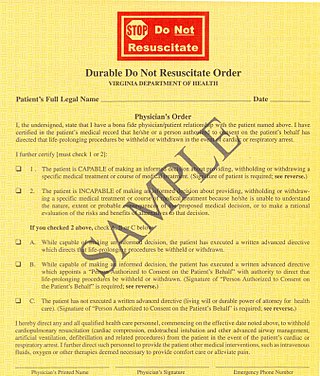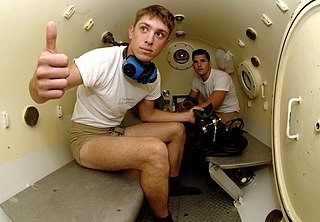
Dog tag is an informal but common term for a specific type of identification tag worn by military personnel. The tags' primary use is for the identification of casualties; they have information about the individual written on them, including identification and essential basic medical information such as blood type and history of inoculations. They often indicate a religious preference as well.

A do-not-resuscitate order (DNR), also known as Do Not Attempt Resuscitation (DNAR), Do Not Attempt Cardiopulmonary Resuscitation (DNACPR), no code or allow natural death, is a medical order, written or oral depending on the jurisdiction, indicating that a person should not receive cardiopulmonary resuscitation (CPR) if that person's heart stops beating. Sometimes these decisions and the relevant documents also encompass decisions around other critical or life-prolonging medical interventions. The legal status and processes surrounding DNR orders vary in different polities. Most commonly, the order is placed by a physician based on a combination of medical judgement and patient involvement.

A bracelet is an article of jewellery that is worn around the wrist. Bracelets may serve different uses, such as being worn as an ornament. When worn as ornaments, bracelets may have a supportive function to hold other items of decoration, such as charms. Medical and identity information are marked on some bracelets, such as allergy bracelets, hospital patient-identification tags, and bracelet tags for newborn babies. Bracelets may be worn to signify a certain phenomenon, such as breast cancer awareness, or for religious/cultural purposes.

A first responder is a person with specialized training who is among the first to arrive and provide assistance or incident resolution at the scene of an emergency. First responders typically include law enforcement officers, emergency medical services members, and fire service members. In some jurisdictions, emergency department personnel, such as doctors and nurses, are also required to respond to disasters and critical situations, designating them first responders; in other jurisdictions, military and security forces may also be authorized to act as first responders.
Basic life support (BLS) is a level of medical care which is used for patients with life-threatening illnesses or injuries until they can be given full medical care by advanced life support providers. It can be provided by trained medical personnel, such as emergency medical technicians, and by qualified bystanders.

A medical tattoo is a tattoo used to treat a condition, communicate medical information, or mark a body location for treatment. People may get a paramedical tattoo to conceal a condition or the effects of treatment, such as creating the appearance of an areola after breast reconstruction, or a cover-up tattoo to disguise the area in an artistic way.
The Seattle & King County Emergency Medical Services System is a fire-based two-tier response system providing prehospital basic and advanced life support services.

A medical identification tag is a small emblem or tag worn on a bracelet, neck chain, or on the clothing bearing a message that the wearer has an important medical condition that might require immediate attention. For emergency medical providers such as paramedics and emergency physicians, medical identification tags are particularly useful in situations where the wearer is unconscious, altered mental status, very young, or otherwise unable to provide critical medical information. The tag is often made out of stainless steel or sterling silver. A wallet card with the same information may be used instead of or along with a tag, and a stick-on medical ID tag may be added or used alone.

Diving medicine, also called undersea and hyperbaric medicine (UHB), is the diagnosis, treatment and prevention of conditions caused by humans entering the undersea environment. It includes the effects on the body of pressure on gases, the diagnosis and treatment of conditions caused by marine hazards and how relationships of a diver's fitness to dive affect a diver's safety. Diving medical practitioners are also expected to be competent in the examination of divers and potential divers to determine fitness to dive.

Wristbands are encircling strips worn on the wrist or lower forearm. The term may refer to a bracelet-like band, similar to that of a wristwatch, to the cuff or other part of a sleeve that covers the wrist, or decorative or functional bands worn on the wrist for many different reasons. Wristbands are often worn and used similarly to event passes such as lanyards to information or allow people entry to events. These wristbands are made from loops of plastic that are placed around the wrist and are used for identification purposes.

A combat medic is responsible for providing emergency medical treatment at a point of wounding in a combat or training environment, as well as primary care and health protection and evacuation from a point of injury or illness. Additionally, medics may also be responsible for the creation, oversight, and execution of long-term patient care plans in consultation with or in the absence of a readily available doctor or advanced practice provider. Combat medics may be used in hospitals and clinics, where they have the opportunity to work in additional roles, such as operating medical and laboratory equipment and performing and assisting with procedures.
In Case of Emergency (ICE) is a programme designed to enable first responders, such as paramedics, firefighters, and police officers, as well as hospital personnel, to contact the next of kin of the owner of a mobile phone in order to obtain important medical or support information. The phone entry should supplement or complement written information or indicators. The programme was conceived in the mid-2000s and promoted by British paramedic Bob Brotchie in May 2005. It encourages people to enter emergency contacts in their mobile phone address book under the name 'ICE'. Alternatively, a person can list multiple emergency contacts as 'ICE1', 'ICE2', etc.

A panic alarm is an electronic device that can easily be activated to request help during an emergency where danger to persons or property exists. It is designed to contact assistance quicker, easier, and simpler than a conventional phone call.

Emergency Health Services (EHS) is a branch of the Nova Scotia Department of Health tasked with providing emergency medical services. It is also responsible for transportation of patients between hospitals and medical facilities. At present, all ground ambulance and air ambulance service in Nova Scotia is contracted by EHS to Emergency Medical Care (EMC), a subsidiary of Medavie Health Services.

The Vial of Life, also known as Vial of L.I.F.E. is a program that allows individuals to have their complete medical information ready in their home for emergency personnel to reference during an emergency. The program is used to provide the patient's medical information when a patient is not able to speak or remember this information. Vial of Life programs are commonly used by senior citizens and promoted by senior center organizations, fire departments, and other community organizations.
Divers Alert Network (DAN) is a group of not-for-profit organizations dedicated to improving diving safety for all divers. It was founded in Durham, North Carolina, United States, in 1980 at Duke University providing 24/7 telephonic hot-line diving medical assistance. Since then the organization has expanded globally and now has independent regional organizations in North America, Europe, Japan, Asia-Pacific and Southern Africa.
Elective surgery or elective procedure is surgery that is scheduled in advance because it does not involve a medical emergency. Semi-elective surgery is a surgery that must be done to preserve the patient's life, but does not need to be performed immediately. Most surgeries are elective, scheduled at a time to suit the surgeon, hospital, and patient.
The following outline is provided as an overview of and topical guide to emergency medicine:

VITAband is a silicone encircling strip worn on the wrist. It can be referred to a bracelet-like band of a wristwatch, to the cuff or other part of a sleeve that covers the wrist. It is a lightweight, waterproof and hypoallergenic flexible wristband that is used when jogging, running, cycling or hiking, or when carrying a wallet is inconvenient. VITAband holds emergency medical information and Visa RFID credit card information. The wristband has two unique features. It comprises an integrated Visa Debit card with payWave wireless functionality and a toll-free phone number with unique identity code that can be used by EMTs to retrieve health information and contacts in case of an accident or health emergency.

Fitness to dive, specifically the medical fitness to dive, is the medical and physical suitability of a diver to function safely in the underwater environment using underwater diving equipment and procedures. Depending on the circumstances, it may be established with a signed statement by the diver that they do not have any of the listed disqualifying conditions. The diver must be able to fulfill the ordinary physical requirements of diving as per the detailed medical examination by a physician registered as a medical examiner of divers following a procedural checklist. A legal document of fitness to dive issued by the medical examiner is also necessary.














